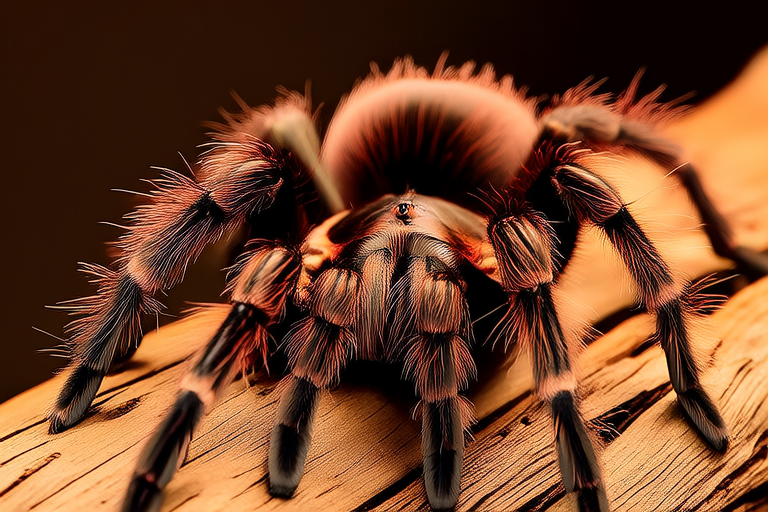From Fear to Fascination: The Charm of Keeping a Chilean Rose Tarantula as Pet
Welcome to an exploration into the world of one of the most misunderstood creatures on Earth – the Chilean Rose Tarantula. Often associated with fear and revulsion, this small but fascinating arachnid is gaining popularity among pet enthusiasts who are discovering its charm and ease of care. This article aims to dispel common fears about tarantulas, delve into the benefits of owning one, provide essential care tips, habitat setup guidelines, feeding and handling instructions, and address potential health issues. By the end, you’ll understand why these unique pets can change your perception from fear to fascination.
The Myth-Busting Introduction
Tarantulas have long been feared due to their appearance and reputation in popular culture. However, the Chilean Rose Tarantula (Grammostola rosea) is far from the aggressive, venomous creature many imagine. With a lifespan of up to 20 years, these spiders are docile and relatively easy to care for. They rarely bite humans unless provoked or mishandled. In fact, their bite is no more harmful than a bee sting. My own experience with my first pet tarantula was enlightening; it taught me that these creatures are not just fascinating but also gentle companions.
Benefits of Owning a Chilean Rose Tarantula
Owning a Chilean Rose Tarantula offers several benefits. Firstly, they require minimal space, making them ideal for apartment dwellers. Secondly, their care routine is straightforward, requiring only occasional feeding and cleaning. Lastly, observing their behavior can be both educational and entertaining. Watching them molt or hunt for prey can provide hours of enjoyment. Additionally, studies show that interacting with pets like tarantulas can reduce stress levels and improve mental health.
Essential Care Tips
Caring for a Chilean Rose Tarantula involves maintaining optimal temperature and humidity levels within their enclosure. Ideal temperatures range between 75°F and 85°F (24°C to 29°C), while humidity should be kept at around 60%. Providing hiding spots such as cork bark or hollow logs helps them feel secure. Regular cleaning of the enclosure prevents the buildup of bacteria and ensures good hygiene.
Habitat Setup Guidelines
Setting up the perfect habitat for your Chilean Rose Tarantula requires careful consideration. A glass terrarium measuring approximately 10 gallons (38 liters) is sufficient for an adult spider. Substrate options include coconut fiber or organic potting soil, which should be at least 3 inches deep. Ensure there’s adequate ventilation by using mesh covers or screen lids. Decorative elements like live plants or artificial plants can enhance aesthetics without compromising safety.
Feeding and Handling Instructions
Chilean Rose Tarantulas primarily feed on insects like crickets, mealworms, and dubia roaches. Feed juveniles every few days, reducing frequency to once weekly for adults. Gut loading feeder insects with nutritious foods enhances nutritional value. Handling should be done carefully, avoiding sudden movements that might startle the spider. Always support the abdomen when holding, never grasp legs or body directly.
Potential Health Issues
Like any other animal, Chilean Rose Tarantulas may face certain health challenges. Common issues include dehydration, mites, and respiratory problems caused by poor environmental conditions. Regular monitoring of weight and activity levels helps detect early signs of illness. Consulting with veterinarians specializing in exotic animals provides expert advice on treatment methods.
Changing Perceptions: From Fear to Fascination
My journey with my Chilean Rose Tarantula has been transformative. Initially apprehensive about sharing my home with such a creature, I soon found myself captivated by its graceful movements and intriguing behaviors. Sharing stories about my pet has sparked curiosity among friends and family members, leading to more open discussions about different types of pets. Through education and interaction, we can shift societal attitudes towards acceptance and appreciation of these remarkable beings.
In conclusion, keeping a Chilean Rose Tarantula as a pet presents numerous advantages alongside responsibilities. By understanding their needs and providing appropriate care, owners can foster strong bonds with these fascinating creatures. Let us embrace our role in promoting positive perceptions of tarantulas and celebrate their place within the diverse world of companion animals.
